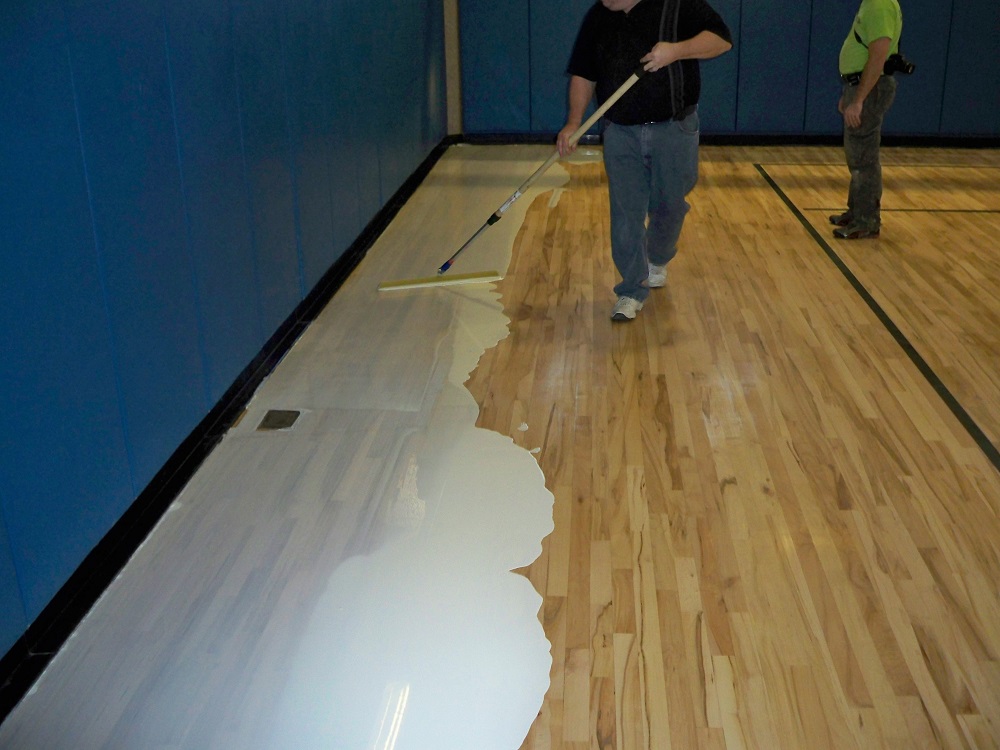Polyballs are beads of paint or finish that protrude from cracks in the floor when the moisture content (MC) of the wood rises, causing the cracks to close up. A paint polyball is a serious problem, as it can be smeared over the rest of the floor – potentially requiring screening or even recoating. Polyballs typically occur in the spring on jobs that were completed the previous winter. Here’s why:
- Wood furnished from the north in winter is typically supplied at low moisture content. It is milled at around 6% MC and stored at about the same.
- During winter, even in the south, humidity is at its lowest. Couple this with possible heating at the facility and moisture content can be even lower.
- If the floor is laid and finished at this low moisture content, there will be considerable expansion in the spring during higher humidity. This can cause great compression of any paint or finish in the cracks of the floor.
- Paint and finish that accumulate in the cracks of the floor are denied the oxygen required for curing, and could be soft (semi-solid) when the spring expansion occurs. Facility owners and operators may be resistant to maintaining proper temperature and humidity in their facilities due to the high cost of air conditioning. Therefore, we must estimate the worst-case temperature and humidity as an acclimation condition. (On the other hand, floors laid in spring and summer will acclimate to a higher, more representative MC, thereby lessening the problem.)
First, we must establish or estimate the highest moisture content (MC) of the year for the floor to be installed. Use the chart NWFA (water and wood) Handbook chart to estimate the normal MC of the wood, based on temperatures and relative humidity (RH).
Consider an example of predominant winter conditions of 50°F and 25% RH. This is when the floor is to be laid and finished. For this same facility, we can project a spring or summer condition of 70°F and 75% RH. Refer to the chart and you will see a moisture content change from 5.5% to 14.4% or a change of 8.9%! This translates into a dimensional change of 0.70″ across ten 2¼” boards (8.9 x 10 x 2.25″ x .00353). (Change in MC x # of boards x board width x expansion factor for maple).
Of course, this dimension increase is not possible, and is translated into extreme pressure between boards – the type of pressure that causes polyballs. If this floor had been laid and finished at a moisture content closer to the worst case of 14.4, there would have been little expansion and no polyballs.
To ensure polyballs do not ever happen, pay close attention to this winter moisture content problem of both the subfloor and the flooring. When moisture content is low, it must be raised through the use of humidifiers or other means.
To check moisture content without a moisture meter, or if you question the meter reading, assemble ten boards and measure overall width. These boards were milled at 6%. For every 1% of moisture content over that at which it was milled, these ten boards will grow in width about an eighth of an inch. Use this guide to establish the proper moisture content. If there are open cracks in the floor, assume low moisture content. Increase the moisture content before applying the finish.
As an additional measure to prevent polyballs, we recommend that multiple layers of paint NOT be used. There is a new masking system that allows the use of only one layer of paint, even on logos. As an example, if you were going to letter a school name on a border using this new system, you would paint the letters first. Then a computer-generated mask is placed over the letters and the border is painted. This actually leaves a small amount of wood showing around the perimeter and the inside of the letters, which looks more professional.
When polyballs do crop up, get to them QUICKLY. Oftentimes, these balls can be wiped up with mineral spirits if they are still wet. If they have become hard, a straight edge or a drywall knife can be used to break them off. Train your local maintenance personnel on how to deal with them and the problem will not be severe.
Everyone’s warranty should require that the facility owner maintain the proper temperature and humidity conditions in any facility with a wood floor. The consequences of not doing so (i.e. polyballs, cupping, etc.) should be clearly explained. This will at least give you a point of negotiation when dealing with the problem.



